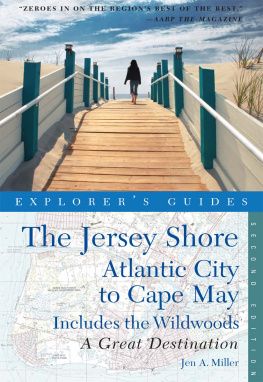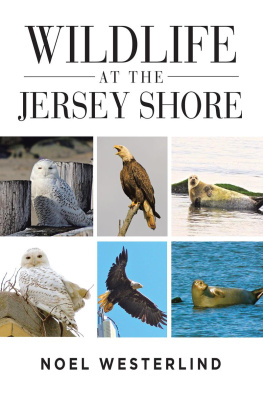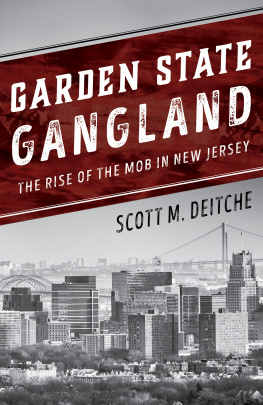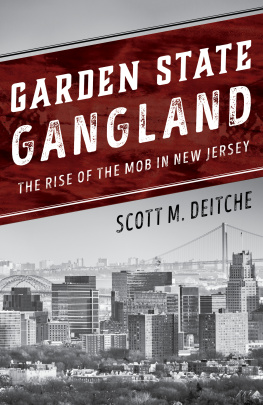

Published by The History Press
Charleston, SC 29403
www.historypress.net
Copyright 2015 by Randall Gabrielan
All rights reserved
Front cover, top left: The high-rise, begun in 1973, was abandoned unfinished after the builders 1974 bankruptcy. For years known as the skeleton, the project, which endured, as does the Jersey Shore, was completed in 1982. Named the Admiralty, the condominiumized building overlooks the water in Monmouth Beach. Authors photo.
First published 2015
e-book edition 2015
ISBN 978.1.62585.234.2
Library of Congress Control Number: 2015932932
print edition ISBN 978.1.62619.706.0
Notice: The information in this book is true and complete to the best of our knowledge. It is offered without guarantee on the part of the author or The History Press. The author and The History Press disclaim all liability in connection with the use of this book.
All rights reserved. No part of this book may be reproduced or transmitted in any form whatsoever without prior written permission from the publisher except in the case of brief quotations embodied in critical articles and reviews.
CONTENTS
Baker Brothers: Philip Pontius (18461920);
Jacob Thompson (18471919); Latimer (18491932)
ACKNOWLEDGEMENTS
I thank the many who contributed, notably three facilities in Ocean County. Special merit to the Ocean County Historical Society, their librarian Betsy Dudas and her volunteers; the Ocean County Cultural and Heritage Commission and Division Director Timothy G. Hart; and the New Jersey Maritime Museum and curator Deborah Whitcraft. Lenders of pictures are acknowledged under their contributions. Unacknowledged pictures are mine.
I thank all who provided information. Special appreciation goes to professionals who contributed from their own work, including Joan Berkey, architectural historian, and Margaret Westfield, preservation architect. Thanks to Gerald Beer, Margaret Buchholz, Patricia H. Burke, Eileen Chapman, Judith Courter, Elaine and Roy Everett, Susan Sandlass Gardiner, Kathleen Heim, Bob Hentges, Ferd Klebold, Gil Leibrick, G.W.C. Bill McCarter, Casey Madrick of United States Military Academy Archives, Don Nyce, Gary Saretzky and Pete Stemmer.
INTRODUCTION
My narrative history of the Jersey Shore will reveal early explorers, our once-unoccupied beaches with the subsistence living of nearby residents, dangerous maritime trades, the spreading of splendid resorts and the shores transformation to a residential domain. These crucial topics may render a risk of omitting the people who shaped the shore. Human interest adds color and life to inanimate structures and environments, so those who made the shore New Jerseys most endearing landscape merit their own volume.
This work had numerous choices for inclusion, but space constraints influenced selection and length of the biographical sketches. The book includes many of the shores most important figures, but subjectivity influenced the selection of interesting figures who added color and depth to the shores past. Some were picked to the exclusion of others with greater significance. Others have stories that merit elevation from historical obscurity. Selection was an art of balancing significance, interest and merit. This is purview of the author, and not only do I take responsibility for the biographical lineup, but I will match this group of 114 entries against any other of that number for any standard of measure.
The organization is first topical, then alphabetical. Birth and death dates are enumerated when known. Thus, the table of contents will direct the reader to fields of interest, while subjects dates will provide insight to any period.
A variety of checked sources were utilized for most entries. In some instance sources are specified in the profiles while others are noted in the selected bibliography. No attempt was made to cite well-known information.
ARTISTS AND ARCHITECTS
ERNEST A. AREND (18761950)
Ernest Augustus Arend, born in Trenton, represents skilled local architects with scant biographical records but in possession of large bodies of fine work. They should be known by their commissions, notably Arend, a major Monmouth figure of the first third of the twentieth century.
Arend initially practiced in his native city in the Brouse and Arend firm. He relocated to Asbury Park around 1900, leaving the Trenton office to former partner Samuel Brouse. Arends career was centered in the environs of Asbury Park and the Red Bank area where he lived. One of his earliest buildings is the North Asbury Park Engine and Hose Company, a frame, extant Classical Revival structure. He secured numerous municipal and school contracts. These included Asbury Park High School and Stadium from the late 1920s. Earlier he designed there what was the latest advance in segregated education, the 1913 Bangs Avenue School, now the closed Barack Obama School, two separate buildings, the larger for whites and the smaller for blacks, each with entrances on adjoining streets, the two connected by an auditorium for mutual use.
In Middletown, by 1920, he had expanded the Leonardo High School, which had been completed only a few years prior, and the modest Port Monmouth School. This simple Colonial Revival design was reinterpreted with greater flourish ten years later with the Leonardo Elementary School. Perhaps Arends most visible school project is the former Neptune High School located on the east side of Highway 71 or Main Street, a short distance south of Asbury Park, a building now adaptively used as the Jersey Shore Arts Center. Other large prominent Monmouth school projects include the 1928 Collegiate Gothic former Long Branch High School and the 1917 Red Bank High School, now a middle school.
Ernest Arends design Blossom Cove became the site that mandated equalized valuation.
Arend utilized the Colonial Revival as one of his two favored residential designs, including 2 Blossom Cove Road, Middletown. At number 44 is his other style, the Italian Renaissance Revival for Everett Brown. This house became a center of the United States croquet sport when owned by Olivia Switz. It also became a real estate landmark as her successful appeal of an assessment, the case Switz v. Middletown, established the principle of equalized valuation. Arend regularly utilized this stucco-clad model, modified for houses of varied sizes, including his own built on upper Broad Street, Red Bank, one since destroyed. This design also appeared as a sample house of the National Fireproofing Company (NATCO) and in an advertisement for Atlas Portland Cement. Arend was Monmouth County consultant to Sears for mail-order houses.
Arend maintained a New York office, or address, as did many suburban architects. His only known New York City building was a restaurant-loft at 17 West 17th Street, done for an Allenhurst, New Jersey owner. The diversity of his output is further reflected by a 1929 project, a clubhouse built over the water for the Shrewsbury River Yacht Club in Fair Haven.
Arends affiliations included the Masons, Elks, Asbury Park Rotary and the Monmouth County Society of Architects, forerunner of the Jersey Shore Chapter of the American Institute of Architects. Arend was a key practitioner of his era, with significant commissions that enrich the landscape.










